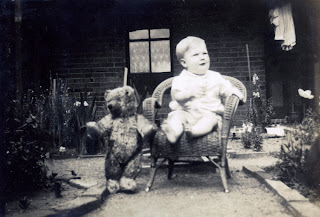This is my second "brick walls" blog, inspired by
James Tanner's recent posts. In this
case I want to explain why some brick walls will never be breached, no matter
how many obscure sources you know about and check. This is because sometimes there never were
any records about a person created in the first place. This could be the case
(at least in New South Wales) well into the 19th century.
The example I am going to use is William Flynn, known to
have existed in the Parramatta area of NSW in the 1850s. How do we know he existed? He first came to
light on the death certificate of his daughter, Mary Ann Julia Annesley (nee
Flynn). She died in 1930, aged 78
(indicating a birth about 1852). Her
death certificate gives her parents as William Flynn, labourer, and
Lucretia. As an aside, we are lucky with
New South Wales and Victorian death certificates, which contain much more
information than their English equivalents.
They are much closer to Scottish death certificates. The NSW death
indexes also contain the death of a William Flynn aged 76 in 1919 (thus born
about 1843). His parents were William Flynn, labourer, and Lucretia Haslam. The
NSW birth indexes include a reference to a baptism of Albert Flinn, son of
William and Lucretia Flinn, at Parramatta in 1852. This is before the start of civil
registration in NSW (which commenced in 1856), so this is a church record. It is a baptism in St Patrick's Roman
Catholic Church at Parramatta, and says that Albert was born 6 Jun 1852 and
baptised on 10 June. His father is
stated to be a labourer, living in Parramatta.
 |
St Patrick's in Parramatta c1860. Photo from National Library
of Australia |
So we appear to have three children, but there is only a
baptism of one of them. I have checked
through the microfilm of the original register in case a relevant entry was
omitted or mis-transcribed, but there was nothing else for the name Flynn or
Flinn (or other variant).
William and Lucretia obviously married before civil
registration started. That is if, indeed, they ever did marry. No record can be found in the church records
of a marriage between them. I then tried to look for deaths. As you can imagine, there are a lot of deaths
of people named William Flynn/Flinn (47 in NSW between 1850 and 1930, none of
them from the Parramatta area), so the logical step would be to find Lucretia's
death (nice unusual name, isn't it) and see if there was a clue as to whether
William was alive or not at that time. But no death can be found for Lucretia
(or any obvious variant of that name) in any state of Australia or New Zealand.
Their son Albert is probably the infant who died in 1852, though I haven't
checked that church record. William the son died in country NSW in 1919, and
had married a woman called Annie Amelia King.
His death certificate says that the marriage took place in Parramatta,
but doesn't give a date. No such
marriage can be found. There is nothing else on his death certificate that
gives us any further clues about his parents.
So that is the sum total of what I can find about William
Flynn the father. He had children
William (c.1843), Mary Ann Julia (c. 1852) and Albert (born 1852). He was a labourer, and lived in Parramatta.
He baptised one child in the RC church, so we can deduce that he was probably
RC himself. Given that, and that his
name was William Flynn, it is probable that he was either born in Ireland, or
the descendant of someone who was. But we don't have any clues as to where or
when he was born, or the names of his parents.
So here comes the reason why I may never find anything
else. It is possible that both William
and Lucretia died before civil registration started in 1856, which would
account for the failure to find death certificates. As a labourer he probably would not have owned
land. He wasn't a tradesman advertising his services. If he did not get into trouble he would not
be in official records (like court records).
And if he did nothing notable he would not be mentioned in the
newspapers (I forgot to say that I keep checking those with no success). Even if there was a baptism for him in NSW
(and at various times Catholic masses and churches were banned within the
colony) I wouldn't have the information to know that a baptism I had found was
the correct person. He just didn't leave
a paper trail.
I will never stop looking for him when any new information
becomes available, but I'm not holding out any hope.


















